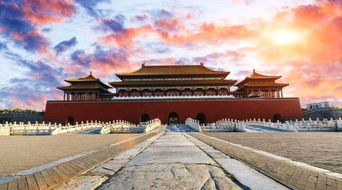故宫英语典故(故宫的历史英文)
1.故宫的历史(英文)
In 1406 (yunglo four years), Ming emperor awarded by Beijing, ordered the ennui of nanjing palace construction Beijing modeled after palace. In 1420 (yunglo 18 years), Beijing completed palace. The following year the fire, the first three house destroyed by fire. 1441 years (orthodox six years), the reconstruction of the first three house and dry qing dynasty palace. 1557 years (jiajing, the Forbidden City fire 36 years), the first three house reared, door, wenwu building, all meridian gate burned, to 1561 years to rebuild all finish. 1597 years of wanli (25 years), the Forbidden City, the fire burned three house before the hall of supreme harmony, and (house, the house and three palace (after), dry palace, hand over tai temple, kun better th). Reconstruction project until 1627 (apocalypse seven years) party completion. In 1644 (17 years), li chongzhen compromised Beijing, the Ming dynasty perish army. Li before the Forbidden City, only retreat burned WuYingDian, build a house, anglo-chinese temple, and NaXun house, around watchtower and the emperor extremely the door is not burned, the rest of the building were all destroyed. In the same year ShunZhiDi clear from shenyang moved to Beijing. Since then lasted for 14 years, will the middle building basic repair. In 1683 kang xi (twenty-two years), and began to build the rest of the Forbidden City were destroyed buildings, to 34 years basic completion. Kang xi In 1735 the qing (13 years), clear the emperor qianlong emperor) (six decades since then acceded to the Forbidden City, for more on a large scale and rebuilt. In 1813 (18 years), TianLiJiao jiaqing; Muslim insurgents LinQing rate against the Forbidden City. The palace treasure (7) in 1900, a coalition of eight compromised Beijing. The g8 coalition in the Forbidden City parade. In 1911, wuchang uprising broke out, qing emperor abdicated. But with the republic of China in accordance with the optimal conditions, signed in the Forbidden City still lives. In 1923, JianFuGong fires. In 1924, launched "feng yuxiang Beijing coup", drive the qing emperor aisin giorro puyi. In 1925, in the Forbidden City built on the foundation of the national Palace Museum. In 1933, the Palace Museum, to avoid cultural relics head further south Japanese aggression. In 1948, the Palace Museum head further south part of cultural relics to Taiwan. In January 1949, beiping (i.e. Beijing) stability, the Palace Museum open recovery. In 1961, with the approval of the state council, Beijing the imperial palace was designated as the first batch key units of cultural relics protection. In 1987, Beijing the imperial palace included in UNESCO world heritage list. In 2002, Beijing the imperial palace to a 19 years of overhaul.。
2.北京故宫英文介绍
北京故宫是中国明清两代的皇家宫殿,旧称紫禁城,位于北京中轴线的中心,是中国古代宫廷建筑之精华。
The the Imperial Palace of Beijing is the imperial palace of the two dynasties in Ming and Qing Dynasties, formerly known as the Forbidden City, located in the center of Beijing's central axis. It is the cream of ancient Chinese palace architecture.北京故宫以三大殿为中心,占地面积72万平方米,建筑面积约15万平方米,有大小宫殿七十多座,房屋九千余间。是世界上现存规模最大、保存最为完整的木质结构古建筑之一。
Beijing Palace Museum is centered on three main halls, covering an area of 720,000 square meters, with a construction area of about 150,000 square meters. It has more than 70 palaces and more than 9,000 houses. It is one of the largest and most complete ancient wooden structures in the world.北京故宫于明成祖永乐四年(1406年)开始建设,以南京故宫为蓝本营建,到永乐十八年(1420年)建成。The Beijing Palace Museum was built in 1406 in Yongle, Chengzu, Ming Dynasty. It was built on the basis of the Nanjing Palace Museum and completed in 1420 in Yongle, Ming Dynasty.它是一座长方形城池,南北长961米,东西宽753米,四面围有高10米的城墙,城外有宽52米的护城河。
紫禁城内的建筑分为外朝和内廷两部分。It is a rectangular city pool, 961 meters long north and south, 753 meters wide East and west, surrounded by a wall 10 meters high, and 52 meters wide moat outside. The buildings in the Forbidden City are divided into two parts: the Outer Dynasty and the Inner Court.外朝的中心为太和殿、中和殿、保和殿,统称三大殿,是国家举行大典礼的地方。
The center of the foreign Dynasty is the Hall of Taihe, the Hall of Zhonghe and the Hall of Baohe, which are collectively called the three halls. 内廷的中心是乾清宫、交泰殿、坤宁宫,统称后三宫,是皇帝和皇后居住的正宫。They are the places where the national ceremonies are held. The center of the Inner Court is the Qianqing Palace, Jiaotai Palace and Kunning Palace, which are collectively called the Hou Three Palaces and are the main palace where emperors and queens live.扩展资料:一、名称考义 故宫又称紫禁城。
中国古代讲究“天人合一”的规划理念,用天上的星辰与都城规划相对应,以突出政权的合法性和皇权的至高性。天帝居住在紫微宫,而人间皇帝自诩为受命于天的“天子”,其居所应象征紫微宫以与天帝对应,《后汉书》载“天有紫微宫,是上帝之所居也。
王者立宫,象而为之”。紫微、紫垣、紫宫等便成了帝王宫殿的代称。
由于封建皇宫在古代属于禁地,常人不能进入,故称为“紫禁”。但明朝初期称为“皇城”,直接称呼为“紫禁城”则大约始于明朝中晚期。
二、建筑规模 北京故宫由明朝皇帝朱棣始建,设计者为蒯祥(1397—1481年,字廷瑞,苏州人)。占地72万平方米(长961米,宽753米),建筑面积约15万平方米,占地面积72万平方米,用100万民工。
共建了14年,有房屋9999间半,实际据1973年专家现场测量故宫有大小院落90多座,房屋有980座,共计8707间(而此“间”并非现今房间之概念,此处“间”指四根房柱所形成的空间)。参考资料来源:百度百科-北京故宫。
3.故宫有什么典故
三大殿院不种树
故宫太和殿、中和殿、保和殿并称外朝三大殿,是皇帝举行盛典的地方,从位置上说居整个外宫建筑的中心,也是整个北京城的中心。为了突出这组宫殿的威严气势,建筑上采取了许多手法,其一便是院内不植树,从皇城正门天安门起,经端门、午门、太和门,这之间的一系列庭院内都无树木(现在端门前后的树是辛亥革命以后种植的)。当时人们去朝见天子,进入天安门,经过漫长御道,在层层起伏变化的建筑空间中行进,会感到一种无形的,不断增长的精神压力,最后进入太和门,看到宽阔的广场与高耸在三重台基上的巍峨大殿,这种精神压力达到顶点。宽阔的广场、蓝蓝的天空,把三大殿映衬得更加威严壮观。而这正是至高无上的天子对自己臣民所要求的。如果在这些庭院内都种上树,绿荫宜人,小鸟鸣叫,那将会破坏朝廷的威严氛围。 故宫三大殿上没有树木的第二个原因是中国古代皇帝在五行中属“土”,“木”克“土”,因此没有“木”。太和殿、中和殿和保和殿的台基就是一个坐北朝南的“土”字。第三个原因是:谨防刺客进入,伤及皇上、大臣。保护皇上不受侵害。
4.北京故宫的英文简介5句,拜托拜托
Beijing the imperial palace, old called the Forbidden City, is China's twenty-four emperors of the Ming and qing dynasties imperial palace, it is the essence of the han palace architecture, incomparable ancient architecture masterpiece, is also the world's largest and most complete existing the ancient wooden structure buildings.。

声明:本网站尊重并保护知识产权,根据《信息网络传播权保护条例》,如果我们转载的作品侵犯了您的权利,请在一个月内通知我们,我们会及时删除。
蜀ICP备2020033479号-4 Copyright © 2016 学习鸟. 页面生成时间:0.222秒